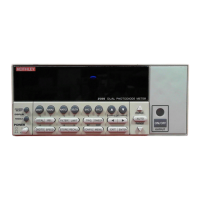13-10 Remote Operations Models 2500 and 2502 User’s Manual
SRQ
You can program the instrument to generate a service request (SRQ) when one or more
errors or conditions occur. When this indicator is on, a service request has been generated.
This indicator stays on until the serial poll byte is read or all the conditions that caused
SRQ have been cleared. See Section 14 for more information.
LOCAL key
The LOCAL key cancels the remote state and restores local operation of the instrument.
Pressing the LOCAL key also turns off the REM indicator and returns the display to nor-
mal if a user-defined message was displayed.
If the LLO (Local Lockout) command is in effect, the LOCAL key is also inoperative.
For safety reasons, the OUTPUT key can be used to turn the output off while in LLO.
Programming syntax
The information in this section covers syntax for both common commands and SCPI com-
mands. For information not covered here, see the IEEE-488.2 and SCPI standards. See
Section 15 and Section 17 for more details on common and SCPI commands, respectively.
Command words
Program messages are made up of one or more command words.
Commands and command parameters
Common commands and SCPI commands may or may not use a parameter. The following
are some examples:
*SAV <NRf> Parameter (NRf) required
*RST No parameter used
:CALCulate1:STATe <b> Parameter <b> required
:SYSTem:PRESet No parameter used
NOTE At least one space between the command word and the parameter is required.
Brackets [ ] — Some command words are enclosed in brackets ([ ]). These brackets are
used to denote an optional command word that does not need to be included in the pro-
gram message. For example:
:INITiate[:IMMediate]
Test Equipment Depot - 800.517.8431 - 99 Washington Street Melrose, MA 02176
TestEquipmentDepot.com

